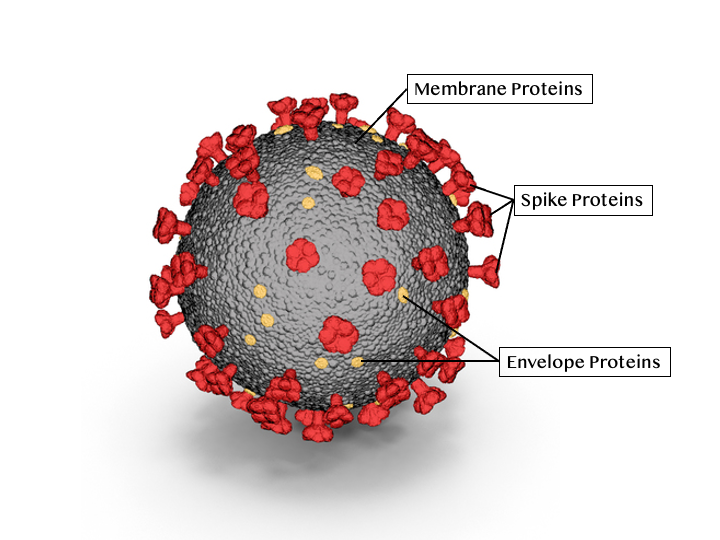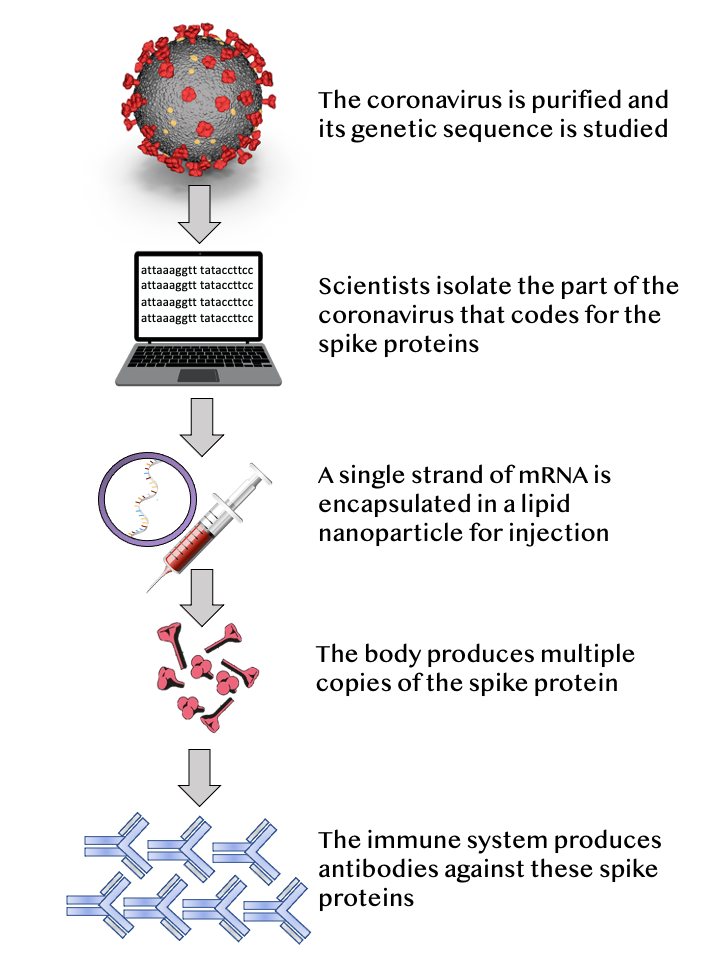What you need to know about COVID-19 mRNA vaccines
In November 2020, Pfizer/BioNTech and Moderna made the COVID-19 mRNA vaccines against SARS-CoV-2 (a.k.a. coronavirus) a reality. So, when Pfizer/BioNTech and Moderna released their studies, I did not hesitate to take a deep dive. I wanted to know what I needed to know about these COVID-19 mRNA vaccines. Here’s what I learned.

But before we get into the COVID-19 mRNA vaccines details, let’s talk about the immune system and traditional vaccines first.
What does your immune system do?
When a virus enters your body, it will attach itself to one of your cells and inject its DNA or RNA into that cell. DNA is like a blueprint for our cells – it contains instructions on what the cell has to make. So, the coronavirus’ RNA will tell your cells to make more copies of it. Your cell containing the virus becomes a virus factory. Essentially, pumping out new copies of the virus, which can then infect even more of your cells.
Essentially, once the virus enters your body, it will hijack your cells machinery to make more copies of itself. That’s how viruses survive inside you and make you sick.
Your Immune System is Your Natural Defence
But there’s no need for concern because our immune system naturally has defence mechanisms to fight off foreign intruders. Your immune system will attack any protein, virus, or bacterium that does not belong in our bodies. However, is that it takes a few days for your immune system to learn how to attack the intruder.
Meanwhile, the virus factories are running non-stop, quickly replicating the virus and spreading it in your body. In other words, you start experiencing symptoms of whatever virus that has infected you. And this happens before your body has a chance to learn how to fend it off.
After a few days, however, your immune system has figured out how to attack the virus. And thus, will start producing powerful antibodies against that virus. These antibodies attach themselves to the virus, preventing them from infecting more cells and marking them for destruction.
As you can see, our immune system is remarkable at defending our bodies from foreign intruders. But it’s also slow to mount an attack because it requires time to learn how to mount the attack. That is why we get sick in the first place. It is the time from when we are infected with the virus to the time your immune system figures out how to fight off the virus. So, to give our immune system a helping hand, scientists developed vaccines.
How do traditional vaccines work?
First of all, every vaccine only works on one specific virus or bacterium. And the main goal of a vaccine is to teach your immune system: (1) what that virus (or bacterium) looks like. And (2) how to respond to that threat before an infection can occur.

Image created by HER’OLOGY; image may be subject to copyright.
It is like showing your immune system a mug shot of the virus or bacterium and saying: “if you see this, kill it!” Essentially, vaccines prime your immune system and arms it with the tools to fight off anything foreign that enters your body.
Traditional vaccines often work by exposing your immune system to a weakened or dead version of a virus or bacteria, such as the annual flu vaccine or the measles vaccine. Other vaccines, such as the Hepatitis B or the HPV vaccine, work differently by only using a small part of a virus instead of the whole virus to prime your immune system.
The Pfizer/BioNTech and Moderna mRNA coronavirus vaccine rely on latter method of vaccine technology with a few tweaks.
How do mRNA vaccines work?
In every cell of your body, you have DNA. DNA stores all the information and instructions important to the functioning of your cells and ultimately, what makes you you. Nearly every function in the human body is carried out by proteins, and so, our cells are constantly manufacturing them. To make these proteins, inside your cell is machinery that reads through your DNA. It then makes a copy of it, called messenger RNA (or mRNA). Each strand of mRNA holds the instructions on how to make one specific type of protein. A separate group of your cell’s machinery will read the mRNA. And follow the instructions and make that specific protein that your body needs. That’s where the Pfizer/BioNTech and Moderna mRNA vaccines come in. They contain specific genetic instructions for your cells to make a specific protein.
To understand how the Pfizer/BioNTech and Moderna mRNA vaccines work, let’s look at an image of the coronavirus. The coronavirus has these distinctive spikes, called spike proteins and these spikes allow the coronavirus to attach to the ACE-2 receptors on the surface of your cell, enter the cell, and infect it.

Once inside your cell, it will hijack your cell’s machinery to make more copies of itself. That’s how the coronavirus survives inside you. And ultimately, make you sick by continuously making copies of itself inside your body and thereby infecting more cells.
And so, the key idea for the coronavirus mRNA vaccine is to train our immune system to recognize these spikes. It does this by having our own body produce them using mRNA instructions from the vaccine.
How COVID-19 mRNA Vaccines Protects You
To do this, scientists isolated the portion of the virus DNA that codes for the spike proteins. Armed with this code, they copied it creating the mRNA. Which contains instructions to build the spike proteins of the coronavirus, not the entire virus itself, just the spikes.
In order to transport and protect the spike protein-mRNA, every strand of mRNA is encased in a lipid nanoparticle. This is essentially tiny fatty droplets surrounding each piece of genetic material. When you get the COVID-19 mRNA vaccine, your cell’s machinery will read the mRNA instructions and unwittingly start building large quantities of the spike proteins, which on its own, the spikes are harmless. With the spike proteins in your body, your immune system will recognize them as foreign. As a result, kick into action. It will start learning how to attack these spike proteins by creating powerful antibodies against them. These antibodies will destroy all the spike proteins in your body. It even breaks down the mRNA instructions itself. Thus, leaving no trace of the mRNA vaccine in your body.
Again, it takes time for your immune system to fight off these spikes. But you won’t get sick because it is only the spikes that it is fighting, not the entire virus itself. And this antibody has a memory system, stored in your memory B cells, and can linger around for months. So, if you are ever get infected with the real coronavirus in the future, your body now has the upper hand.

Lastly, I want to make clear that the injected COVID-19 mRNA never enters your cell’s nucleus. The nucleus is where your unique genetic code, your DNA, is located. So, although mRNA is genetic material, it does not change or even interact with your genes. This is a common misconception.
How were the vaccines developed so fast?
Developing traditional vaccines is usually a very lengthy process. It can take, on average, 8 years to get approved. This is because vaccines are very difficult to get right and be safe. Traditional vaccines require growing and transporting large amounts of live viruses or bacteria in a lab. Then, studying and researching how they work. And lastly, creating the vaccine itself, which is a time-consuming process.
Unlike traditional vaccines, once the DNA of a virus is determined, the mRNA vaccines can be made in a lab. This is done with readily available materials to create mRNA molecules. So, it does not require developing a weakened version of the actual virus. Which then needs to get in you to prime your immune system. These mRNA vaccines can pass many hurdles. It is by using your own body’s cell machinery in an ingenious way to create virus-destroying antibodies.
Also, scientists have actually been studying the possibilities of custom-made mRNA for decades. And even tried using mRNA technology to treat cancer and heart disease.
So, in actuality, this seemingly “new kid on the block” mRNA technology isn’t so new at all.
Although it seems that mRNA vaccines only just new on the market with the emergence of coronavirus. The fact is mRNA vaccines are used in humans for other infectious diseases, such as rabies, influenza, and the Zika virus in the past.
And lastly, a global pandemic has certainly increased the funding and resources going towards developing these mRNA COVID-19 vaccines. Which has helped to speed up their development.
How effective are these mRNA COVID-19 vaccines?
The important thing for people to understand is that both the Pfizer/BioNTech and Moderna mRNA COVID-19 vaccines are extremely effective at what they say it does. Meaning that, it does an extremely good job at reducing your risk of getting COVID-19. And, perhaps more importantly, it also significantly reduces the chance of getting extremely sick from the virus – lessens symptom severity. But based on the current data, both vaccines do not completely eliminate your chances from getting COVID-19. Nor does it completely prevent transmission of the coronavirus to others if you do get the virus.
In other words, it is possible to get COVID-19 even after vaccination. But the key takeaway is: if you get two doses of either mRNA vaccines and remain asymptomatic 14 days after, there is a 99.95% and 99.92%, respectively, chance that you won’t get COVID-19 from the original strain of the coronavirus. But if you do get COVID-19 even after vaccination, you are also less likely to get severely sick and hospitalized. This may also mean it may lessen your ability to pass on the coronavirus if you are sick. Thus, it reduces transmission. It is because these vaccines provide enough protection to reduce the number of virus particles. This is known as reduced viral load.
Are these mRNA COVID-19 vaccines safe?
Given that it is a relatively new technology, should you be concerned at all? Well, that’s what these initial clinical trial stages have been for. Not only to test whether or not they work, but also to make sure they have minimal side effects. So, based on all the current research, the Pfizer/BioNTech and Moderna mRNA COVID-19 vaccines have a very good safety profile. As of right now, we have four-month follow-up data of participants. This is after their second dose. Results from ~70,000 people given these mRNA vaccines show no serious concerns. This is a good sign for any vaccine or drug, for that matter.
With that said, however, it is normal to experience mild to moderate side effects. This is because your body is building immunity. Common side effects of these COVID-19 mRNA vaccines include:
- Pain at the injection site
- Fatigue
- Nausea
- Headache
- Mild to moderate fever
- Body chills
In rare cases, a person might experience an allergic reaction to one or more of the ingredients in a vaccine. They might develop hives or another type of skin rash, swelling, and mild respiratory symptoms.
COVID-19 mRNA Vaccines Are Carefully Researched
Yes, the mRNA COVID-19 vaccines were developed more quickly than traditional vaccines. But they have been carefully tested. More, they continue to be monitored. Not just by Pfizer/BioNTech and Moderna. Also by other non-affiliated independent safety monitoring boards and governmental agencies, such as the FDA and Health Canada.
A caveat, however, is that there is not enough current available safety data to determine long-term effects. In order to generate that data, time is required as the clinical trials continue.
Lastly and most importantly, the Pfizer/BioNTech and Moderna mRNA COVID-19 vaccines cannot cause COVID-19. This is because these vaccines only contain a small portion of the coronavirus’ genetic code that make the spike proteins. They do not contain the complete form of the virus responsible for COVID-19.
SUMMARY: Here’s what we know about COVID-19 mRNA Vaccines
Let’s summarize what we really know about these mRNA COVID-19 vaccines:
- You cannot get COVID-19 from the Pfizer/BioNTech and Moderna mRNA COVID-19 vaccines.
- The Pfizer/BioNTech and Moderna mRNA COVID-19 vaccines do not interfere with your genes, your DNA.
- The Pfizer/BioNTech and Moderna mRNA COVID-19 vaccines decrease the chances of you getting COVID-19.
- If you get COVID-19 after vaccination, you are less likely to get severely sick. And less likely to be in the hospital. It also lessens your chances of transmitting it to others.
And lastly,
- All current data suggest both mRNA COVID-19 vaccines are safe; however, more research is needed to fully determine the long-term safety of these vaccines.
CONCLUDING REMARKS
Although the current data suggests that these mRNA COVID-19 vaccines do not completely provide 100% protection. But the data does suggest it is safe. It also gives your immune system a huge boost against the coronavirus. So, the research says, you are better equipped with fighting the coronavirus when vaccinated.
I hope all this information is useful, concise, and educational for you. Understanding how things work helps make things seem less unknown and scary in this very strange time.
If you have any questions or comments, please share your thoughts below!





Very informative, thank you
Is this the same for AstraZeneca vaccine
Thank you for taking the time to read it, Liz. I’m glad you found it informative.
The Pfizer & Moderna mRNA vaccines I discuss in this article is not the same as the AstraZeneca vaccine. It is similar in that it is genetic material being injected, but instead of mRNA it is actually DNA in the AstraZeneca vaccine. It also uses different vehicle to get inside cells.
I hope that helps!
Excellent and easy to understand article! Well done Kim!
Hi Sharon!
Thank you so much! I’m glad that it was an easy read!
Hope you’re doing well.
Kim
Well written, Kim! Your explanations are expressed in plain language and the images you’ve chosen add clarity. Thank you for Herology 🙂
Hi Martha,
Thank you so much! 😊 I’m glad it was an easy read! And you’re welcome! I hope we can all learn from each other through HER’OLOGY!
~Kim